Street Photographers - The Facts
Street Photographers - The Facts
Blog Article
Some Known Incorrect Statements About Street Photographers
Table of ContentsAll About Street PhotographersWhat Does Street Photographers Do?What Does Street Photographers Do?Street Photographers Fundamentals ExplainedThe Main Principles Of Street Photographers
A category of photography that records day-to-day life in a public area. The actual publicness of the setting enables the photographer to take candid images of complete strangers, commonly without their understanding. Road photographers do not always have a social objective in mind, but they prefer to separate and catch minutes which could otherwise go unnoticed (Street Photographers).He was influenced by several of those who affected the street digital photographers of the 1950s and '60s, he was not chiefly interested in recording the spirit of the street. The impulse to aesthetically document people in public started with 19th-century painters such as Edgar Degas, douard Manet, and Henri de Toulouse-Lautrec, who functioned side by side with photographers attempting to record the essence of city life.
Because of the fairly primitive innovation available to him and the lengthy exposure time needed, he had a hard time to record the hustle and bustle of the Paris streets. He try out a series of photographic techniques, trying to locate one that would certainly allow him to catch motion without a blur, and he located some success with the calotype, patented in 1841 by William Henry Fox Talbot. Unlike Atget, professional photographer Charles Marville was worked with by the city of Paris to develop an encyclopaedic document of Haussmann's metropolitan planning job as it unravelled, hence old and brand-new Paris. While the digital photographers' topic was essentially the exact same, the outcomes were considerably different, demonstrating the impact of the professional photographer's bent on the personality of the pictures he created.
Given the fine quality of his photos and the breadth of material, architects and artists typically got Atget's prints to utilize as recommendation for their very own work, though commercial interests were hardly his main motivation. Rather, he was driven to picture every last residue of the Paris he enjoyed.
Street Photographers Fundamentals Explained
They reveal the city with his eyes. His job and basic understanding of digital photography as an art kind served as ideas to generations of digital photographers that complied with. The next generation of road professional photographers, though they likely did not describe themselves therefore, was ushered in by the photojournalism of Hungarian-born digital photographer Andr Kertsz.
Unlike his peers, Brassa made use of a larger-format Voigtlnder video camera with a much longer exposure time, compeling him to be a lot more calculated and thoughtful in his method than he might have been if utilizing a Leica. (It is thought that he might not have been able to pay for a Leica at that time, yet he did, however, make use of one in the late 1950s to take colour photographs.) Brassa's pictures of the Paris underworld lit up by artificial light were a discovery, and the collection of the series that he released, (1933 ), was a significant success.
Cartier-Bresson was a champion of the Leica Continued cam and among the first professional photographers to optimize its capabilities. The Leica enabled the digital photographer to interact with the surroundings and to record minutes as they happened. Its fairly little dimension additionally helped the photographer discolor right into the history, which was Cartier-Bresson's recommended technique.
All about Street Photographers
It is due to the fact that of this basic understanding of the art of image taking that he is usually anchor attributed with finding the tool around once again roughly a century because its innovation. He took photos for greater than a half century and affected generations of digital photographers to trust their eye and instinct in the minute.
These are the concerns I shall attempt to address: And after that I'll leave you with my very own meaning of street digital photography. Yes, we do. Allow's begin with defining what an interpretation is: According to (Street Photographers) it is: "The act of specifying, or of making something guaranteed, distinct, or clear"
No, definitely not. The term is both restricting and misdirecting. Appears like a street photography need to be pictures of a roads ideal?! And all road digital photographers, besides a handful of absolute newbies, will totally appreciate that a street is not the crucial element to road photography, and actually if it's an image of a street with possibly a few monotonous people not doing anything of interest, that's not road photography that's a photo of a street.
Some Ideas on Street Photographers You Need To Know
He makes a legitimate point do not you assume? However, while I agree with him I'm uncertain "honest public photography" will capture on (although I do kind of like the term "candid photography") since "street digital photography" has been around for a long time, with numerous masters' names affixed to it, so I believe the term is right here to remain.
Inside?! I hear you yell as you tremble your clenched fist to the skies. Why not? You can contend the coastline, at an event, in a street, in a park, in a piazza, in a coffee shop, at a gallery or art gallery, in a city terminal, at an occasion, on a bridge, under a bridge ...

4 Simple Techniques For Street Photographers

Report this page